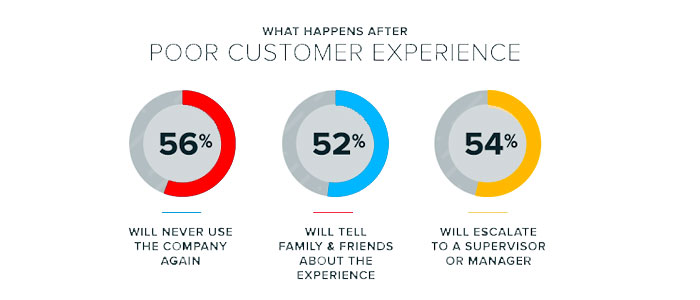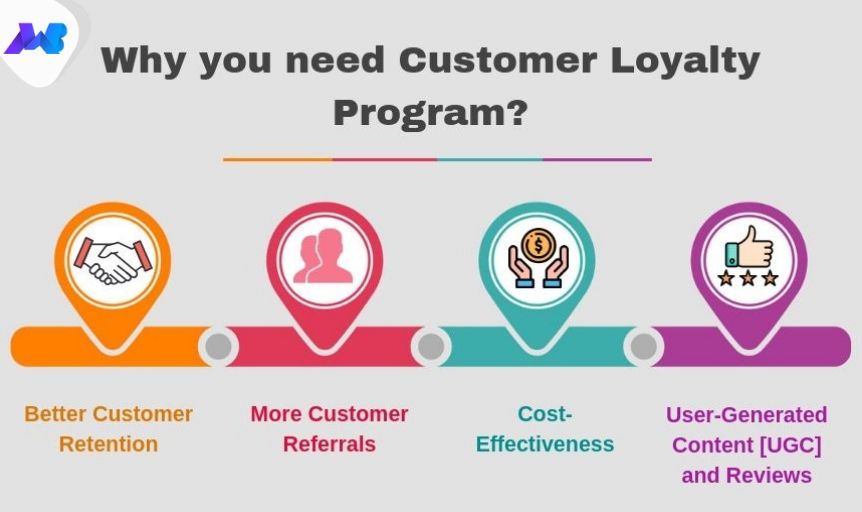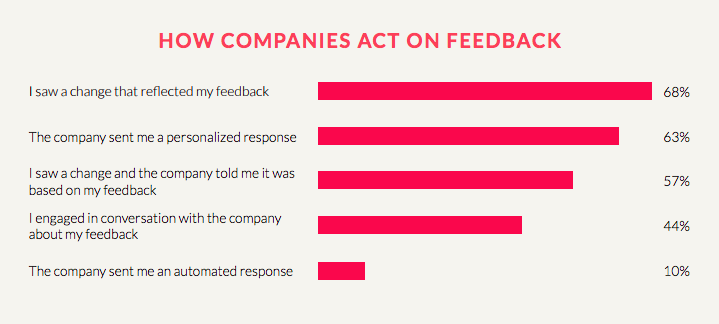
Contact Center, Productivity, Innovations
4 Effective Ways To Enhance Profit In Contact Centers

Today's marketplace remains supremely competitive. The key to staying relevant as a business lies in what services a company can offer or how good their product is, and how robust its customer service ecosystem is. The company needs to research well into their most regular customers' profiles – or even into the groups that provide most of their revenue to make sure their service network is well suited to their needs and not arbitrarily offered to customers.
Forrester's report suggests that low and impersonal customer experience can cause customers to drop intended purchases, which translates to an estimated $62 billion in lost sales in the US in 2015 – a concerning 51% increase over the previous two years.
Generous support creates a strong customer relationship. Nevertheless, it is imperative to know some common customer service mistakes to avoid, especially considering the most active generation on the internet today has access to a broader range of information than the generation before. Poor customer support can significantly damage the firm's public reputation.
It has often been a somewhat common trend to leave agents with some instruction manual or other forms of knowledge base articles to look into by the said firm. This is to provide themselves with knowledge on how to deal with a customer seeking support. However, being human makes them prone to error and fallibility. Thus it is essential to provide support agents with adequate and regular training. Trainers must conduct mock sessions to stay updated on market trends and make sure agents ask the right questions to diagnose a client's problems and not commit avoidable customer service mistakes.
This is a prevalent mistake made by companies. Many alienated customers remain quiet about their issues until they are reached out to by the firm. Customer churn is the result of this mistake. It is crucial to avoid this since the loss of customers directly translates into a loss of revenue. The customer service department should keep aside separate time to perform root cause analysis and process analysis. They should proactively contact the customer to check up instead of waiting for the company phone to ring. Helpdesk software can be installed to automate specific tasks. The team must be trained to share the links to resources like frequently asked questions or set up videos with every response proactively.

Source: Reve Chat
This is the Achilles heel for customers. A company's clients may well be in entirely separate time zones, but they would want their issues to be resolved ASAP, regardless. The company thus has to avoid this customer service mistake. Customers lose faith, and the firm's reputation takes a loss when they cannot contact support. Hiring enough staff members and implementing a chatbot is a convenient solution to handle all the incoming customer requests. At times, and perhaps most often, customers would want to speak with support over the phone and solve their issues. This demands the service provider to put their phone number on their website where it's easy to find.
Listening to a person with intent is a great skill and must be cultivated by the service team. It is a failure if the respondent support agent comes up with a not entirely relevant solution to the customer's query. A fundamental customer service mistake to avoid is not to assume things on their own. A right agent will be differentiated from a subpar one by being fully attentive and refraining from asking the client to repeat their query. Customer Satisfaction (CSAT) Survey in a company's help desk software is a valuable method to collect accurate feedback from customers. This can help in judging the quality of the support team's response.
It is an age-old business adage to avoid the grave mistake of over-promise and under-deliver. It will be a welcome change for customers if it is the other way round, and this customer service mistake is why many companies fail to stay relevant in the marketplace. It is suggested to inform the customer about the delay in progress and apologize to them if they fail to commit.
Customers will expect their queries to be answered quickly without too much waiting time. Long wait times would bother anyone. However, it is essential to note that these waiting times are not limited to phone calls and happens in all customer support modes like chat, social media etc. Another Forrester report suggests that around half of all customers expect support within 6 hours, but only around 36% of companies can do that. This is a significant customer service mistake to avoid if one has to stay ahead of the competition.
Anyone in touch with the current marketplace acknowledges that customer retention is the key to higher and faster revenue growth and helps create new customers. It has been observed that businesses with omnichannel support had up to 89% customer retention, whereas those without one closed in on a mere 33%. This highlights the importance of being available where the customer seeks to support and not the other way round.
It is essential to make a customer feel welcome and in a known environment to provide them with the best service and keep their discomfort at bay. A company might do everything right but not maintaining consistency with a client's profile, and their previous queries might create a road no business wants to travel down. A CRM will record the customer journey with the brand. Agents can access this information to make the customer feel more welcome with personalized interaction. This also enables the company to curate their services if the customer has faced similar problems previously.

It is a major irritant for a customer when they dial in to seek help in resolving an issue and are instead met with a barrage of arguments detailing how the customer did something wrong and not the company. Trying to justify your company's mistakes and issues is lousy customer service. Agents need to take responsibility for when things go wrong and not put the blame on the customer. Dealing with the customer to resolve their issue is the focus, not defending the company.
Customers are getting used to automation and that is saving time at both the ends. So far so good. But with the zeal of automation, some organization have completely removed the human interaction. Automation only smoothens the process; however, human interaction is still considered satisfactory and also necessary when it’s a complex issue. Scripted responses are unoriginal and convey to the customer that the company does not care about them.
This would translate into the standard response of being unable to consider just because it does not adhere to 'company protocols.' Whenever a customer faces any issue, they expect an immediate and satisfactory resolution, and it is in the job profile of a support agent to do exactly that. Going an extra step to help a customer will impart brand loyalty and creates room for upselling. Thus, managers should enable agents to go out of the usual protocol to assist customers in specific scenarios.
Having the customer sit through 5 transferred calls and 4 departments is not the best customer service. In fact, it is a primary customer service mistake that any company should avoid at all costs. All customers like feeling valued. Nothing conveys precisely the opposite of that sentiment than treating customers like just another phone call that needs to be done away with. Proper IVRs or helpdesk systems can route the customer to the correct department, making it a time-wise efficient choice.
All individuals with industry knowledge would agree on loyal customers being the best advocates available out there. While maintaining historical records of customers’ interaction is essential, it is also necessary to identify customers who have remained loyal to the brand over multiple quarters. Extra steps can be taken, often with little to no hassle, like sending out promotions with a touch of personalization or even limited-time offers on birthdays or during a particular festive season.

Souce: Make Web Better
Often during escalations in calls, an angry customer might complain about and demand harsh steps be taken against a particular service agent. In such situations, the supervisor must validate the customer's feelings and immediately resolve the issue. However, it is equally necessary for the agent to feel supported by the supervisor and not alienated. This will give them the confidence to keep working at the same level they have before and boost employee morale.
Regular analysis of customer support calls is something many businesses fail to consider. That pushes them behind the curve while competing with firms that offer similar products or services. Providing the support team with feedback on where to improve and what to avoid precisely creates ground to streamline the content and quality of support offered by a company. One rep cannot contradict what another agent says, and a different representative cannot promise a customer what the company cannot provide. These are amateur customer service mistakes to avoid, and reasonably easy steps can be taken to do the same.
The customer is always right, but an agent cannot let the customer dictate the conversation. By asking the right questions and prompting the correct responses, the agent must control the conversation flow. It will ensure that the customer and the company are on the same page at the end of the conversation.
A company can maximize its own and the customer's benefit simultaneously by making sure that the customer stays updated with new protocols, offers, terms of service, and products, if any. This is a standard customer service mistake, and it can be avoided through simple means. Regularly scheduled calls, text messages, mailing of brochures, and semi-personalized emails are great methods to update the customer with any information they need to know and thus empower them to make the best decisions for themselves. This increases customer satisfaction and retention, both of which are inversely related to the customer churn rate.
As has been said here before, there are multiple more staying silent and dissatisfied for every customer that contacts the customer support with an unresolved issue. Positive interactions are shared amongst the customer base. Still, as it has been for centuries, negative views travel much faster than positive ones – and it is especially true and hazardous in today's connected world as a considerable portion of transactions takes place every day over the internet. A vital customer service mistake to avoid is thinking that one negative review does not spread further and that it has no chance of having any significant impact whatsoever.
It might sound like something fundamental for a business to take note of while dealing with support queries, but it has been observed that a great many companies leave several issues only half resolved and do not proactively follow up to complete the resolution process. A typical customer service mistake to avoid here is falling into the trap of believing that once the customer has contacted support, the onus of resolving the outstanding issues lies with the customer; it does not. Taking this method out to reduce workload will lead to a silent but destructive amount of customer churn.
As has been pointed out earlier here, millennials have access to a massive range of information on what they require and the best methods to get them. This group of customers spends a lot of time on the internet and remain especially keen to connect and interact with their favorite or regular brands on social media. These websites generate much traffic, including queries for customer support, complaints, reviews, and even suggestions. A company is set to lose massive revenue and goodwill if they regularly fail to interact with or respond to customers through these social media channels. Automation has helped ease the workload, but human agents must be ready and willing to answer when the need arises. Omnichannel support can seamlessly integrate all channels under one hub and ease the workload for agents.
A frustrated customer does move on – only, not from just the problem but often the entire company itself. Most customers have a very low threshold for frustration tolerance and usually switch to a competitor when frustrated more than once (or even once, for many cases). It is dangerous to assume that these customers will return if the company does not proactively take measures to own up to and resolve the problem. It is best if the company provides a couple of extra benefits to the customer to make up for their lack of efficiency in offering first call resolution.
Any business needs to model itself after what most of its customers want the most from it. These ideas are often reflected very clearly in the feedback customers leave below a product or on the company website, or even in the comments of promotional posts. It is also beneficial in identifying friction points between the business and the customer and generally helps improve the overall user experience.

Source: Apptentive
This is another customer service mistake that companies can easily avoid. It is imperative to have faith in what the company is doing and believing in its work ethic. No matter how great the company thinks it is doing, there will always be customers who believe the company can be doing way more – and they are right. While it is impossible to meet every customer's expectation, the business must remain genuinely open to change and implement any such changes as deemed necessary as soon as possible.
A business can provide outstanding support to resolve a customer's issues once or twice. However, despite all that, a customer might still be left feeling unsatisfied. This can happen if the support they receive on all the occasions does not measure up to the company's quality of performance the previous times. The major takeaway here, thus, is that it is vital to not only offer good service but to do so consistently.
A final customer service mistake to avoid would be not to research the quality of service offered by competitors but to improve one's services to only borderline outmatch services provided by rival businesses. Multiple factors influence customer behavior. Over time, brand loyalty, reputation, and other similar factors influence a customer to interact with a particular brand more than marginally better services provided by another company. Any business in today's marketplace must do and be the best that they can and leave the worry of catching up with the competitors.
Superior customer service can become a big differentiator and USP for a brand compared to its competitors. More so when products and services are getting more and more similar and commoditized, customers are in need of a great customer experience. So building a ‘built to last’ organization needs to have its foundation on a great customer service team.

Contact Center, Productivity, Innovations
4 Effective Ways To Enhance Profit In Contact Centers

Contact Center, Dialer, Omnichannel, Productivity
5 Ways Predictive Dialers Make Outbound Contact Centers Successful

Customer Experience, Contact Center
5 Ways Customer Interaction Improves Your Business In 2025